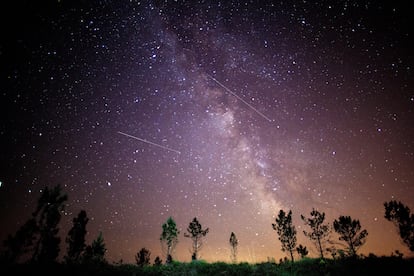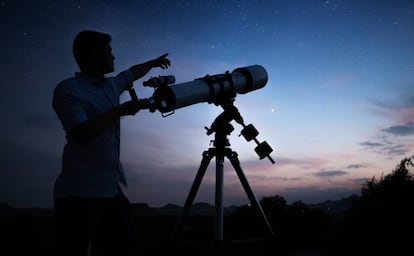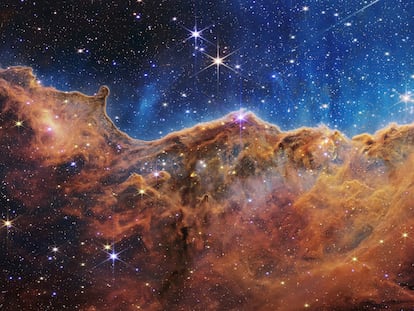How scientists determine the age of a star
Astrophysicist Miriam García answers readers’ questions and explains calculation methods, which vary according to the star’s proximity and whether it is in a cluster

If we identify a star and want to know its age, the first thing we have to do is find out if it’s isolated or part of a cluster or a stellar association. The latter groups can contain anywhere from hundreds to millions of stars.
To determine age, we rely on theoretical models that tell us how stars evolve and what physical properties – such as temperature, luminosity and radius – they should have, depending on how long they’ve been around.
The main method of determining age is a graphical model that we call a color-magnitude diagram. On the X axis, we put the color of the star; on the Y axis, we put the magnitude of its brightness. Stellar populations have a particular appearance according to their age, which is reflected in their position in these diagrams. This is why it’s important to know if the star is in a cluster or if it’s isolated. If it’s in a cluster, the simplest thing is to draw the color-magnitude diagram of the cluster.
Most stars will be part of a diagonal line on the diagram, known as the main sequence. But at the top – which is where they are the brightest – some stars are spaced out and have redder colors. This, from the point of view of physics, means that these stars have exhausted the hydrogen in their core.

Hydrogen fusion is what gives stars their energy. During this stage, the stars are in the main sequence on the color-magnitude diagram. When the hydrogen is depleted, they begin to expand and evolve towards cooler temperatures and redder colors.
The starting hypothesis is that all stars in the clusters formed at the same time, hence, they have the same age. But it’s important to remember that not all stars evolve in the same way: the more massive a star is, the more efficient the fusion of hydrogen inside it, which means they burn their energy faster and deplete it sooner. When this happens, the star enters a new phase of their evolution and departs from the diagonal line on the color-magnitude diagram. Depending on where this turning point is located, the cluster will have one age or another. Since we start with the hypothesis that all clusters formed at the same time, if we have the age of the cluster, we have the age of each of its stars – even though they are not all in the same phase of life.
If, however, we want to know the age of an isolated star, the methods depend on how far away or how close it is. If it’s too far away, there is very little we can do to determine age: the solution would be to consider it as part of a larger population, even if it is not in a cluster. One possibility would be to think of the star as part of the Milky Way’s halo, or as a stellar population, subsequently applying the color-magnitude graph method to it. The Gaia spacecraft allows us to better define these populations, since it has the capacity to identify subgroups of stars in the galactic disk and halo.
If a star is relatively close to Earth, we have different methods available to us. One of them is to find out if we can detect lithium in its spectrum. Lithium runs out very quickly, so if a star shows lithium in its spectrum, it tells us that it is very young. Another method is to look for oscillations in brightness: stars are not static spheres, but undergo periodic expansions and contractions that cause their brightness to change. There are space missions dedicated to studying these variations in the brightness of stars. The length of oscillations can be linked to the stratification of layers of the stellar interior – and the stratification of layers tells us the age of the star!
And now we come to the Sun. Here, we have a little more help, because, in addition to being able to study it in great detail, we are able to determine a date of formation thanks to the composition of meteorites. Before the formation of the Sun, the explosion of a nearby supernova released many heavy elements, resulting in the formation of the entire Solar System. Meteorites reflect the chemical composition of the elements released by the supernova. The methodology to examine them is similar to radiocarbon dating. Since we know the chemical composition and the speed with which certain radioactive elements decay, when studying the composition of meteorites, we can determine the maximum age of the Sun: it had to form after the supernova, otherwise it would have stopped the formation of the solar system.
Miriam García is an astrophysicist. She researches massive stars at the Spanish Astrobiology Center. This article is part of an initiative sponsored by the Dr. Antoni Esteve Foundation and the program L’Oréal-Unesco ‘For Women in Science’, to answer readers’ questions about science and technology, This question was sent in by Rosario Valenzuela Generoso.
Tu suscripción se está usando en otro dispositivo
¿Quieres añadir otro usuario a tu suscripción?
Si continúas leyendo en este dispositivo, no se podrá leer en el otro.
FlechaTu suscripción se está usando en otro dispositivo y solo puedes acceder a EL PAÍS desde un dispositivo a la vez.
Si quieres compartir tu cuenta, cambia tu suscripción a la modalidad Premium, así podrás añadir otro usuario. Cada uno accederá con su propia cuenta de email, lo que os permitirá personalizar vuestra experiencia en EL PAÍS.
¿Tienes una suscripción de empresa? Accede aquí para contratar más cuentas.
En el caso de no saber quién está usando tu cuenta, te recomendamos cambiar tu contraseña aquí.
Si decides continuar compartiendo tu cuenta, este mensaje se mostrará en tu dispositivo y en el de la otra persona que está usando tu cuenta de forma indefinida, afectando a tu experiencia de lectura. Puedes consultar aquí los términos y condiciones de la suscripción digital.
More information
Últimas noticias
NASA discovers Titan doesn’t have an ocean, but a ‘slushy ice layer’ that increases possibility of life
Innocence lost in the forest of the child soldiers: ‘Each leader of the armed group had his girls’
‘Fallout’ or how the world’s largest company turned an anti-capitalist apocalyptic Western into a phenomenon
From inflation to defending migrants: Eileen Higgins and Zohran Mamdani inaugurate the new Democratic resistance against Trump
Most viewed
- ‘El Limones’ and the growing union disguise of Mexican organized crime
- Christian Louboutin: ‘Young people don’t want to be like their parents. And if their parents wear sneakers, they’re going to look for something else’
- The low-cost creative revolution: How technology is making art accessible to everyone
- ‘We are dying’: Cuba sinks into a health crisis amid medicine shortages and misdiagnosis
- Liset Menéndez de la Prida, neuroscientist: ‘It’s not normal to constantly seek pleasure; it’s important to be bored, to be calm’










































